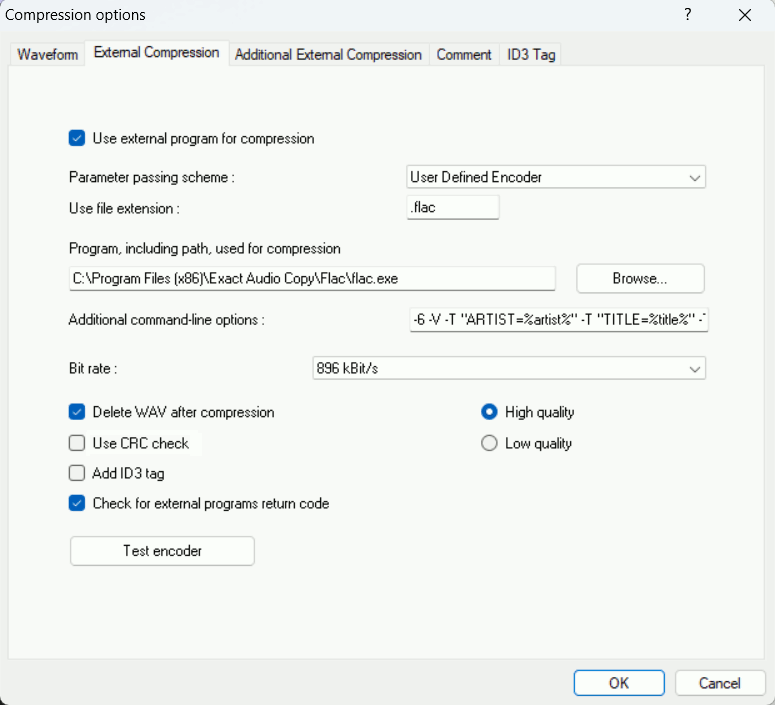EAC and FLAC: Difference between revisions
(→Cue Sheet & Image Problem: typo) |
(→Software Needed: Genericized FLAC link as there is already a new version) |
||
| Line 1: | Line 1: | ||
= Software Needed = | = Software Needed = | ||
* [http://www.exactaudiocopy.de/en/index.php/resources/download/ Exact Audio Copy] | * [http://www.exactaudiocopy.de/en/index.php/resources/download/ Exact Audio Copy] | ||
* [https://xiph.org/flac/download.html FLAC | * [https://xiph.org/flac/download.html Latest FLAC] | ||
= Installation = | = Installation = | ||
Revision as of 13:12, 12 September 2019
Software Needed
Installation
Note: This guide assumes that EAC is has been configured for secure ripping, if not please follow this guide.
- Get FLAC from [[1]] and uncompress the zip archive in Windows' program directory, e.g. "C:\PROGRA~1\flac-1.3.2-win".
- Alternatively EAC comes with its own (old) FLAC encoder in "C:\PROGRA~1\Exact Audio Copy\Flac".
Configuration
- Open EAC and insert a CD into the drive.
- Click the EAC menu and select Compression Options.
- Click the External Compression Tab, and put a tick in the box for use external program for compression.
- Change Parameter Passing Scheme to User Defined Encoder.
- Change Use file extension to .flac if not already that.
- Click the Browse button and locate the FLAC.exe that you unzipped earlier.
- Remove the ticks from Use CRC check and Add ID3 tag.
- Tick Check for external programs return code.
- If you are using EAC 1.0b2 or newer, then in the Additional command line options box, copy and paste the following string:
-T "artist=%artist%" -T "title=%title%" -T "album=%albumtitle%" -T "date=%year%" -T "tracknumber=%tracknr%" -T "genre=%genre%" -5 %source%
- If you are using EAC 1.0b1 or earlier, then in the Additional command line options box, copy and paste the following string:
-T "artist=%a" -T "title=%t" -T "album=%g" -T "date=%y" -T "tracknumber=%n" -T "genre=%m" -5 %s
Note: The green portion is where you would change the compression level.
The range is -0 .. -8 (fastest compression .. highest compression; default is -5). Since Flac is always lossless the effect of the compression level is small and cannot be compared to the compression of lossy formats.
- Do not worry what bit rate is shown in the bit rate drop down box; this will be ignored, as will the quality setting chosen below it.

If you told the EAC configuration wizard to use FLAC, then the command-line options are preconfigured with the following default string. As compared to the string above, the order of parameters is different, more metadata fields are supported (harmless), the output filename is unnecessarily included (-o %dest%), and output verification is unnecessarily enabled (-V):
-6 -V -T "ARTIST=%artist%" -T "TITLE=%title%" -T "ALBUM=%albumtitle%" -T "DATE=%year%" -T "TRACKNUMBER=%tracknr%" -T "GENRE=%genre%" -T "COMMENT=%comment%" -T "BAND=%albuminterpret%" -T "ALBUMARTIST=%albuminterpret%" -T "COMPOSER=%composer%" %haslyrics%--tag-from-file=LYRICS="%lyricsfile%"%haslyrics% -T "DISCNUMBER=%cdnumber%" -T "TOTALDISCS=%totalcds%" -T "TOTALTRACKS=%numtracks%" %hascover%--picture="%coverfile%"%hascover% %source% -o %dest%
External links
Another guide to set up EAC (including some screenshots) by Case
Cue Sheet & Image Problem
Attention: This issue is already fixed in EAC V1.0 beta 3.
Using this configuration with EAC when creating an image and cue sheet rip can cause the cue sheet not to work with the resulting FLAC file. The problem is caused by EAC not liking the four letter .flac extension, which results in EAC putting the extension on to the image name twice.
e.g. the image name is referenced in the cue sheet as "myflacimage.flac" but after encoding it ends up being called "myflacimage.flac.flac", so when you open the cue sheet for playing or burning, the referenced file doesen't exist.
Some solutions to the problem
- Synthetic Soul's batch file method
- REACT EAC addon.
